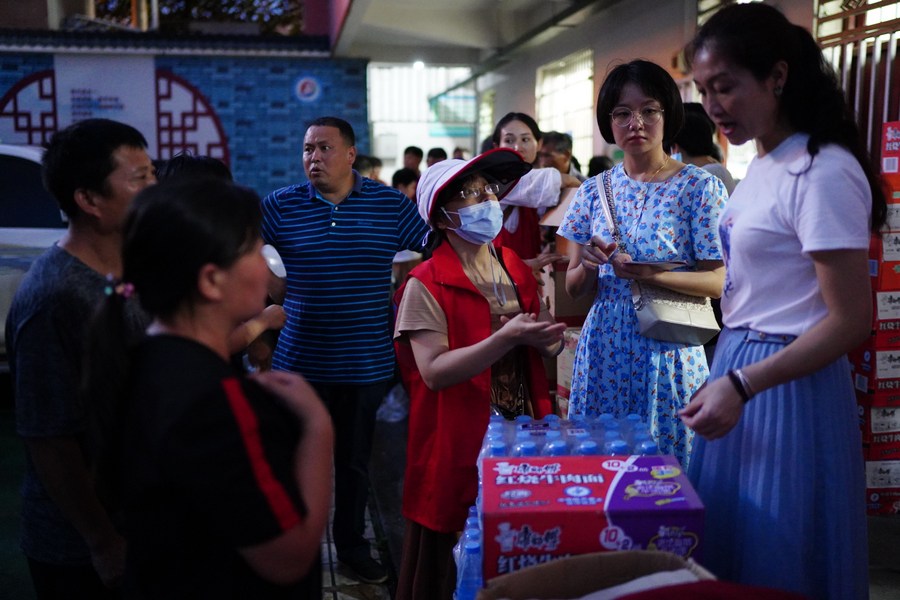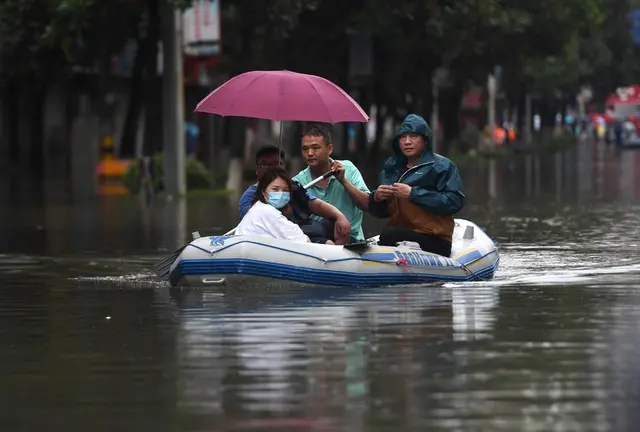- China is bracing for serious flooding in the area of Poyang Lake in Jiangxi Province, as waterlevel at the country's largest freshwater lake rose to 22.6 meters at 10 a.m. Monday, breaking the 22.52-meter record of 1998.
- Jiangxi has made every effort to wrestle with the unfolding disaster, raising its flood-control response to the highest level on Saturday and mobilizing a wide range of resources to tackle flood risks.
- Chineseleadership has called for the greatest efforts to ensure the safety of people's lives and property.
**- The Three Gorges Dam, the largest water-control system along the Yangtze River, has been used to ease the pressure at the middle and lower reaches of the river's main course. **
by Xinhua writers Zhang Zhaoqing, Wu Zhonghao and Lyu Qiuping
NANCHANG, July 13 (Xinhua) -- China is bracing for serious flooding in the area of Poyang Lake in Jiangxi Province, as water level at the country's largest freshwater lake remains high above alert level, amid ongoing torrential rains that have caused widespread flooding along the Yangtze River basin.
The water level at the lake's key Xingzi hydrological station rose to 22.6 meters at 10 a.m. Monday, breaking the 22.52-meter record of 1998, and well above the alert level of 19 meters.
Home to more than 46 million people, Jiangxi has been among the worst affected areas in recent weeks, as the Yangtze River basin witnessed floods following the heaviest average rainfall in decades. There has been unprecedented flooding along several rivers that lead into Poyang Lake, and the rising levels suggest that the overall situation is grim.
Rescue team members transfer flood-stranded people with a rubber boat in Jingdezhen of east China's Jiangxi Province, July 8, 2020. (Xinhua/Wan Xiang)
Jiangxi has made every effort to wrestle with the unfolding disaster, raising its flood-control response to the highest level on Saturday and mobilizing a wide range of resources to tackle flood risks.
Chinese leadership has called for the greatest efforts to ensure the safety of people's lives and property.
UNPRECEDENTED FLOODS
Vice Minister of Emergency Management Zheng Guoguang said that since June, more than 38 million people across the country had been affected by floods, with 141 people dead or missing.
Warning levels had been exceeded in a total of 433 rivers, mainly distributed in the basins of the Yangtze River and Taihu Lake, Zheng told a press conference, adding that the average precipitation in the Yangtze River basin since June is a record high since 1961.
Poyang Lake is fed by several rivers within Jiangxi, and the lake's water then flows into the Yangtze River, China's longest waterway. The water then flows eastward to the sea. As a conjunction point, the lake functions to adjust the water levels of rivers during drought and flood seasons.
Weeks of torrential rains have swelled rivers and lakes in Jiangxi, with several embankment breaches taking place, resulting in flooding on a scale not seen before.

Rescuers build a temporary waterproof dike to stop the flood at Jiangjialing Village in Poyang County, east China's Jiangxi Province, July 11, 2020. (Xinhua/Zhang Haobo)
The provincial flood control and drought relief headquarters said that 2,439 km of the 2,545 km of riverside and lakeside embankments in the province had seen water levels exceeding the warning marks.
Poyang County, located next to Poyang Lake, has already seen no less than 14 of its levee sections breached.
As of Sunday afternoon, floods since July 6 had disrupted the lives of over 5.5 million people in the province, with nearly half a million evacuated from flood-prone areas. A total of 183,000 people were in urgent need of living assistance, according to the headquarters.
The floods damaged over 510,700 hectares of crops and caused a direct economic loss of 8.13 billion yuan (1.16 billion U.S. dollars).
The headquarters predicted that a new round of rainfall would hit the region starting Tuesday.
In Hubei Province, the Three Gorges Dam, the largest water-control system along the Yangtze River, has been used to ease the pressure at the middle and lower reaches of the river's main course. The outbound flow of water has been reduced by almost half to 19,000 cubic meters per second since July 7, withholding much of the floodwater in the Three Gorges reservoir, according to the Yangtze River water resources commission.
The Ministry of Water Resources on Sunday raised the national emergency response for flood control from Level III to Level II, the second-highest in the country's emergency response system.
Chen Tao, the chief weather forecaster at the National Meteorological Center, attributed the continuous rainfall to lingering and stable weather systems, which have kept the rain-belt stationary in the middle and lower reaches of the Yangtze River.
"Compared with before, this year's rainfall was more intense and repeatedly poured down on the same region, which brought significant pressure on flood control," Chen said.
PEOPLE FIRST
Stories emerging from the scene of the flooding have shown the dangers faced by ordinary people, as well as the effectiveness of local efforts.
On the evening of July 8, villagers in Guihu Village of Poyang County were stirred from their dreams by the sound of a gong being beaten.
"Get out of the house! The floods are coming," screamed Huang Guolin, the village's deputy Party chief.
Amid heavy rainfall, Huang dashed from his office when he received the order to evacuate the villagers. He went from door to door, notifying every single person.
Over 9,000 villagers were evacuated to safe places in time before their residences were inundated by floodwaters running through a breach in a dike.
A primary school in Poyang County had already been transformed into an emergency accommodation site, sheltering more than 500 residents.
"Luckily, we still have hot dishes during such a difficult time," said Huang Shengxiang, 58, an evacuated villager who had just received two cooked dishes with meat and fresh vegetables.

Volunteers and government workers distribute living materials to villagers at a temporary relocation site in Poyang County, east China's Jiangxi Province, July 9, 2020. (Xinhua/Zhou Mi)
A storage room at the site was filled with food, drinks and disaster-relief materials, such as folding beds and blankets. People also had free access to boiling water.
The Ministry of Emergency Management (MEM) said Saturday that China had allocated 190 boats, 3,000 tents, 10,000 folding beds, 10,000 blankets and 20,000 quilts to Jiangxi to help with local flood control and disaster relief.
A total of 615 million yuan of disaster-relief funds, allocated by the Ministry of Finance and the MEM, were channeled to flood-ravaged regions, including Jiangxi, Hubei, Anhui and Chongqing.
IMPROVED FLOOD-CONTROL CAPACITY
"In 1998, flood control relied heavily on human beings. It now turns to modern machines and advanced technologies for help," said Cheng Jianyi, a member of the expert group of the flood control and drought relief headquarters in Poyang County, who also joined in the disaster relief efforts during massive floods in 1998.
China Anneng Group Second Engineering Bureau Co., Ltd., a construction corporation that participated in the embankment repair in the county, said it used modern technology to stem the dike breach on July 8. Radar was used to test the water velocity, while GPS was used to measure the water levels.
On Sunday, more than 70,000 people were mobilized in fighting the floods in Jiangxi, aided by over 1,800 sets of mechanical equipment, according to the provincial headquarters.
China has invested heavily in water-conservation projects to enhance its capability to withstand both droughts and flooding. Last year, the country spent a record 726 billion yuan on water-conservation projects.
"We have poured a lot of money into strengthening the large dikes along the Yangtze River and Poyang Lake, but the small and medium-sized levees are still under-invested," said Xu Weiming, secretary-general of the Jiangxi provincial flood control and drought relief headquarters.
(Xinhua reporter Fan Fan contributed to this story; Video reporter: Liu Bin, Yu Gang, Peng Jing; Video editor: Zhang Yichi)
 简体中文
简体中文





